GENETIC DISORDERS PDF
INTRODUCTION:
(genetic disorder) .Determination of sex of an individual at pre-natal stage (before birth or during pregnancy) is called sex-determination. In a number of organisms, one specific part of a chromosome plays a significant role in the determination of sex of the organism. These chromosomes are named as sex-chromosome or allosome or heterosome. Remaining other chromosomes are known as autosomes. The later carry genes which control the somatic traits and have no bearing on the sex. The two members or each pair of homologous autosomes are similar in size and shape, but this may not be true of sex chrosome. (genetic disorder)
DISSIMILAR SEX CHROMOSOME
These chromosomes exhibit FIVE conditions in animals:-
- XX – XY CONDITION: In mammals, including man and insects (fruitfly), one sex chromosome is smaller than the other in the males. The larger is known as X CHROMOSOME and the smaller one as Y CHROMOSOME. (genetic-disorder)
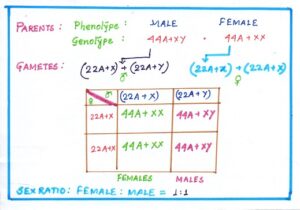
Human beings have 46 chromosomes with 22 pairs of body chromosomes or autosome and 1 pairs of sex chromosome or allosome. During maturation, the sex chromosomes are separated freely with the autosomes resulting the ovum contains 22 autosomes and and one X chromosome, whereas a sperm contains 22 autosomes and either an X or Y chromosome. Y containing sperms are known as ANDROSPERMS and X containing sperms are known as GYNOSPERMS . Fertilization of an egg by GYNOSPERM (X) yields female offspring ; fertilization of an egg by ANDROSPERM (Y) yields male offspring. The offsprings have a sex ratio of 1:1. (genetic-disorder)
- XX – XO CONDITION: In certain insects, such as cockroach and some roundworms, the Y chromosome is missing so that the male has only one sex chromosome. The condition in the male is XO (O means absence of one chromosome) and the female is having XX
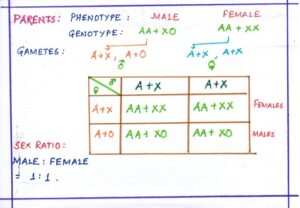
- The male has only one chromosome ( heterogametic). It produces 2 types of sperms: GYNOSPERM WITH X and ANDROSPERM WITHOUT X. Fertilization of an egg (X chromosome) by X bearing sperm yields female offspring (XX), and by no X sperm (0) yields male offspring. The sex ratio of offspring is 1:1.
- ZW –ZZ CONDITION: This mechanism operates in certain in certain insects (butterflies and moths) and invertebrates (fishes, reptiles and birds). The male has two homomorphic sex chromosome (ZZ) and is called HOMOGAMETIC, and the female has two heteromorphic sex chromosome (ZW) and is Thus there are two types of eggs: with Z and with W and only one type of sperm: each with Z.
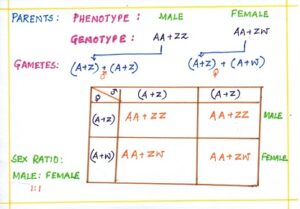
Fertilization of Z chromosome of the egg by the Z chromosome of sperm gives a zygote ( ZZ CHROMOSOME) which develops into a male. Fertilization of W chromosome of the egg by Z chromosome yields a zygote with ZW CHROMOSOME. This zygote produces a female. The offspring will have a sex ratio of 1:1 (one son: one daughter)
- ZO –ZZ CONDITION: This mechanism occurs in certain butterflies and The female is heterogametic and produces two types of eggs: half with Z and half without Z (O) chromosome. The male has homomorphic sex chromosome (ZZ) and is homogametic. It forms only one kind of sperms, each with Z chromosome. The Z containing egg gives to a male offspring (ZZ) and the Z lacking egg produces a female offspring ( ZO).(genetic-disorder)

- Haplodiploidy: Hymenopterons insects show a unique phenomenon in which an unfertilized egg develops into a male and a fertilized egg develops into female. (genetic-disorder)
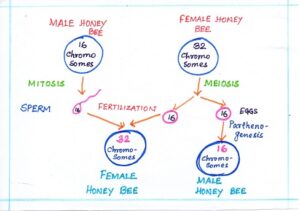
Therefore, the female is diploid (2N) and the male is haploid (N). Eggs are formed by MEIOSIS and sperms by mitosis. Fertilization helps to keep the diploid number of chromosomes in the zygote which gives rise to the female. The unfertilized egg will develop into a male. (genetic-disorder)
GENETIC DISORDERS
In recent years, a large number of human disorders, deformities and diseases have been found to be hereditary. Some of these are caused by gene mutation, others by gross chromosomal abnormalities. The various genetic disorders can be grouped under two broad categories:-
MENDELIAN DISORDERS (genetic-disorder)
- Haemophilia (Bleeder’s disease)
- Sickle-cell anaemia
- Alkaptonuria (alcaptonuria)
- Phenylketonuria
- Albinism
- Red-green colour blindness
- Night blindness
- Muscular dystrophy
- CHROMOSOMAL DISORDERS (genetic-disorder)
- Aneuploidy
- Polyploidy
- Down’s syndrome
- Klinefelter’s syndrome
- Turner’s syndrome
DESCRIPTION OF THE GENETIC DISORDER
HAEMOPHILIA (BLEEDER’S DISEASE)
| CAUSE | SYMPTOMS | INHERITENCE |
| It is a sex linked trait caused by a recessive gene (h) located in the X chromosome. This gene controls the synthesis of a protein needed for the clotting of blood. When this gene mutates, it loses its ability to produce the coagulant .Normal blood is dominant to the defective blood. | This disease prevents clotting while injury. Haemophiliacs bleed excessively when injured. A seriously affected person may bleed to death, after even minor skin cut. |
If only one X chromosome bears a gene for haemophilia, it’s dominant homologous gene in the other X chrosome will check the expression of the recessive gene. Such females are called carriers. |
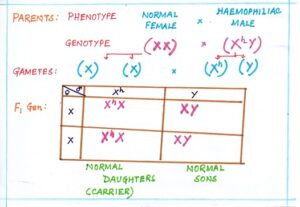
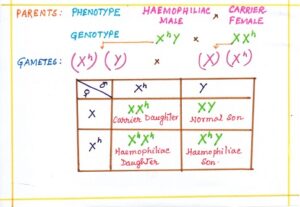
HISTORY: Queen Victoria of England (1819-1901) was a carrier and her son. Leopod, had this defect. Since move of her ancestors and relatives were haemophilic, the mutation probably occurred in sex cellsof her father or mother, or in one of her own germ cells. Leopod survived to a father of a daughter who is also a carrier. Haemophilia spread to royal families of Spain and Russia through marriages of two of Victoria’s daughter. (genetic-disorder)
SICKLE CELL ANAEMIA ( genetic disorder)
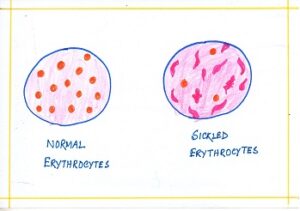
| CAUSE | SYMPTOMS | INHERITENCE |
| This condition is due to the presence of defective type of haemoglobin (sickle-celled haemoglobin ). When haemoglobins of RBCs face Oxygen shortage, their haemogloin molecules are aggregated and form stiff fibres. These fibres distort the cells into odd shapes such as sickles (these corpuscles cannot be easily squeezed through narrow capillaries). These sickle celled RBCs stuck in the small capillaries and reduce circulation to the vessel. These cells are easily broken down resulting decrease number of RBCs leading to anaemia. | Sickle-shaped (crescent)red blood corpuscles are formed under low oxygen condition causing breathing problem. | In this disease there is a change in one nucleotide pair in its DNA. This alteration results in the substitution of one amino acid – Valine for glutamic acid. This small changes turns the Hb A into Hbs. when an individual has both the alleles for sickle-cell haemogloin ( HbsHbs i.e. homozygous) then he is called affected by sickle cell anaemia. |
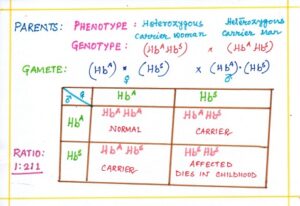
HISTORY: Some 20-40% of people in tropical Africa have the sickle allele in heterozygous condition (carrier) having some selective advantages. The RBCs are having abnormal haemoglobin can sickle more readily when they are infected with malarial parasites. The parasites of sickled cells die. Remaining parasites are destroyed by body’s defense before malaria develops. Thus, the sickle allele in heterozygous condition (HbAHbs) protect the person against malaria.
(genetic-disorder)
ALKAPTONURIA (ALCAPTONURIA)
| CAUSE | SYMPTOMS | INHERITENCE |
| In a normal person, a liver enzyme Homogentisate oxidase catalyzes the breakdown of homogentisic acid to compound that enter Kreb’s cycle to produce CO2 and H2O. The Alcaptonurics are unable to reakdown homogentisic acid because of the absence or inactivity of the enzyme Homogentisate oxidase. | · Blackening of urine on exposure of air.
· Darkening of certain cartilage. · Alcaptonuric person contains Homogentisic acid in their urine, which nis commonly called alcapton or alkapton , which spontaneously combines with Oxygen to form black pigment. · This pigment slowly deposits in the cartilage of ear and nose . · It is also called Mild Arthritis. |
Alcaptonurics lack the normal form of the gene that controls the synthesis of the enzyme. Hence Homogentisic acid is accumulated and excreted out through the urine. |
PHENYLKETONURIA ( PKU)
| CAUSE | SYMPTOMS | INHERITENCE |
| The homozygous recessive individual lacks the enzyme Phenylalanine hydroxylase which is needed to change Phenylalanine to Tyrisine | · It causes extreme mental retardation in children.
· It results in hypopigmentation of skin and eczema. |
Lack of the enzyme is due to the abnormal recessive gene. The affected baby is normal at the irth but within few weeks Phenylalanine level in plasma starts rising and by the age of six months baby develops severe mental retardation. |
ALBINISM ( genetic disorder)
| CAUSE | SYMPTOMS | INHERITENCE |
| It is caused by the absence of the enzyme Tyrosinase which is necessary for the synthesis of the pigment Melanin. | · Characterised by the lack of dark pigment melanin in skin, hair and iris.
· An albino is susceptible to eye disorder due to the damaging effect of bright light. |
The gene for albinism (a) does not produce the enzyme Tyrosinase; but it’s normal allele (A) does. Thus only homozygous individual (aa) is affected. |
RED-GREEN COLOUR BLINDNESS ( genetic disorder)
| CAUSE | SYMPTOMS | INHERITENCE |
| It is produced by an X-linked recessive gene by causing lack of one of the primary cone pigment of the retina. Normal eye-sight is dominant to colour blindness. | Affected human being are unable to distinguish red colour from green colour. | This recessive gene is attached with X chromosome. So female with one affected gene
(XXc) is carrier but male with one affected gene (XcY) is colour blind. |


CONGENITAL NIGHT-BLINDNESS
| CAUSE | SYMPTOMS | INHERITENCE |
|
It is caused by a recessive gene carried by the X chromosome. |
This disease is due to visual purple deficiency that interferes with the function of the retinal rods. | Man suffers from this disease as there is no homologous of the gene in Y chromosome to check it’s expression. Female becomes night blind only if she receives two recessive genes (XnXn) for the defect. |
MUSCULAR DYSTROPHY
| CAUSE | SYMPTOMS | INHERITENCE |
| Victims can’t produce a protein DYSTROPHIN which helps to relay the nerve’s signal to the calcium storage sacs in the muscle cell. As a result calcium is not released and muscle contraction is halted at the very first step. Further, abnormal calcium levels trigger the release of an enzyme which destroys actin and myosin. | This disorder causes deterioration of muscle at an early age. The victim generally has very short life-span, can’t move at age of 10 and dies at the middle of 20 years. | Sex-linked disease due to sex chromosomal gene mutation. The mutated gene on X chromosome fails to produce a protein called DYSTROPHIN. |
CHROMOSOMAL DISORDERS
| DISORDERS | TYPE | RESULT | SYMPTOMS |
| ANEUPLOIDY | Addition or deletion of one or few chromosomes from the usual diploid set of chromosome. | XXY
three times X |
— Sterile male with many female features (sterile female)
–Sterile female with many male features. |
| POLYPLOIDY | Addition of one or more complete sets of chromosome or genome. | AUTOPOLYPLOIDY (AAA)
ALLOPOLYPLOIDY
|
–-e.g. seedless watermelon, grapes and banana.
–new plant species Raphanus brassica from Raphanus (radish)and cabbage (Brassica) |
| DOWN’S SYNDROME | Aneuploid trisomic disease. | OFFSPRING HAS 47 CHROMOSOME (45+XY) | Rounded face, permanently open mouth, short-neck, Mongolian type of folded eyelid. Less intelligence due to malformation of trait. |
| KLINFELTER’S SYNDROME | Aneuploid trisomic disease caused by the union of a non-disjunction XX egg and a normal Y or normal X egg and abnormal XY system. | INDIVIDUAL HAS 47 CHROMOSOME (2n+1) | Sterile male with small testes, long legs, obesity, sparse body hair but with many female characteristics like occurrence of breasts. |
| TURNER’S SYNDROME | Aneuploid monosomic disease caused by union of O egg with normal X sperm OR normal X egg and normal 0 sperm. | INDIVIDUAL HAS 45 CHROMOSOME
(2n-1). |
Sterile female with underdeveloped breasts, reduced ovaries, normal intelligence with many male characters as heavy neck muscle and narrow hip. |